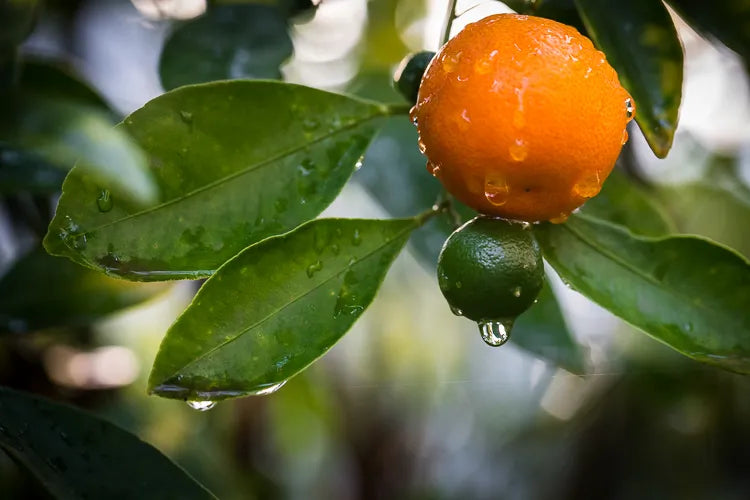Stuck in a creative rut? Don’t worry.
In this article, I share 10 inspirational nature photography ideas, which include plenty of subjects you can find in your own backyard. The ideas are simple, but don’t let that fool you; many of the best nature shots are taken with the most basic of subjects.
(I also offer plenty of nature photo examples. That way, as you go along, you can see the potential each idea offers!)
Let’s dive right in, starting with:
1. Flowers and leaves

If you’re looking for the perfect backyard nature photography idea, then consider shooting flowers and leaves.
As you’re likely well aware, flowers and leaves are everywhere, and they offer an endless variety of colors, shapes, and textures for you to photograph.
You could create a collection of shots based on a single color scheme, or you could experiment with different compositions by photographing as many different leaf or flower shapes as possible.

And try working with different lighting directions. Head out in the evening when the sun is low in the sky, then try to take some beautiful backlit shots that emphasize flower details and leaf veins:


Then adjust your angle until you get some nice front light, which will help describe the subject in all its glory:

Flowers are seasonal, and in temperate zones, spring and summer offer the widest variety of subjects. There are still flowers to be found in winter, although you may need to look harder. Don’t be afraid to photograph dead flowers, and don’t forget that weeds, such as dandelions, are also beautiful!

As for leaves, you can shoot them year-round, though autumn does provide the best color spectrum.

2. Fruit, berries, and seed pods
When the summer flowers disappear, fruits and berries are nature’s way of providing for birds and animals throughout the colder months. And these subjects can provide plenty of opportunities for photographers, too!
Many berries and seed pods ripen toward the end of autumn, and they can look great when shot against leafy backdrops.

And in the winter, you can photograph red berries against white snow. Make sure to choose your exposure carefully as snow-filled scenes can cause problems for camera meters.
You can also photograph acorns, pine cones, and nuts. I’d recommend shooting cloudy days, which will help you emphasize lots of intricate details:

3. Water droplets
Photographers love to photograph raindrops on window panes, but did you know that it’s possible to combine the beauty of raindrops with the lush, verdant hues of nature?
Simply wait until a rain storm ends, grab a macro lens (or your closest-focusing lens), and head outside. Get low to the ground, and carefully observe leaves and grass for water droplets:

Make sure to keep the background uncluttered to avoid drawing attention away from the droplets. Try shooting with a wider aperture and adjusting your angle to create distance between the droplets and the background. Both of these techniques will increase background blur, which will deemphasize distracting features and create a beautiful bokeh effect!


4. Mushrooms, toadstools, and fungi
Mushrooms are ugly photo subjects, right? Not necessarily!
You see, while mushrooms might seem ugly at first glance, once you spend time studying them, you’ll find plenty of hidden beauty worth capturing.
You’ll generally need a macro lens – most mushrooms are tiny, after all! – and you’ll need to be prepared to get down in the dirt for the best images.
These mushrooms looked boring, but when I flattened myself against the ground and found the right light, they suddenly became interesting:

When is the best time to go mushroom hunting? I’d recommend heading out in autumn and winter, though you can also find good subjects just after a spring or summer rain. Look in damp, mossy places, on the sides of trees, and in log piles.
My personal favorites are the red toadstools with white speckles. They are evocative of fairy tales and magic, and their colors are incredible:


5. Shoot up and down
Don’t just photograph the nature subjects right in front of you; instead, go for a walk in the woods, and make sure you spend plenty of time looking up into the sky and down at the ground.
You can create beautiful tree-canopy images using a wide-angle lens:


And you can have lots of fun just lying on the ground, shooting up at the branches. Bonus: It can be pretty relaxing!
Also, when photographing upward, notice how the light changes from early morning into late afternoon and evening. Branches contrast beautifully against a blue sky, and their look is in constant flux depending on the lighting.

Clouds can make beautiful subjects, too. Look for vertical cloud formations, white fluffy clouds, and those lovely soft colors around the edge of the clouds at dusk and dawn.
You can also turn your attention downward. The ground features a million microcosms; look among the moss, around the lawn, between paving stones, and in the fallen bark and leaves. Lie flat on your stomach and peer into another world. And don’t forget that close-up lens!

6. Snails, bugs, and spiders
This nature photography idea is one that you can follow from your backyard (or even from inside your house!).
Simply hunt around for spiders, ants, centipedes, bees, dragonflies, caterpillars, moths, butterflies, and snails. Then, when you find them, get down low, get close, and capture some amazing shots!
I’d recommend using a longer lens; that way, you can avoid scaring the subjects (and you can avoid getting too close yourself!).
And for especially creative shots, make sure to play around with different apertures and lighting effects.
7. Birds and other wildlife
I’m going to be honest:
Compared to flower and leaf photography, wildlife and bird photography is hard.
For one, it requires specialized gear. The longer your lens, the better – and 300mm is generally considered a wildlife photography minimum.
Plus, it requires a lot of patience. You can spend long minutes or even hours waiting for subjects that never seem to appear.
If you’re willing to put in the money and effort, however, capturing wildlife and birds can be a lot of fun!
I’d recommend doing some research into local wildlife hotspots. Then head out with your longest lens during the early morning and late evening. See what you can find.
Make sure you keep your shutter speed fast enough to freeze any action, and be sure to set your camera to its fastest burst mode setting.
If you like the idea of bird photography but you don’t want to spend tons of time searching for subjects, consider creating a feeder setup in your backyard. Then add a perch or two, and – voila! – you can capture stunning bird photos from your kitchen window.

